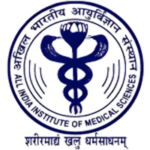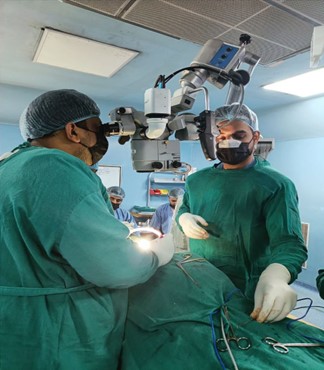
SLIPPED DISC TREATMENT
Lets understand the slipped disc/sciatica/disc prolapse in a simple way …
A normal disc is a very innocent structure and happily lies in between two adjacent vertebral bones doing its job of transmitting load from top to bottom in spine and providing cushioning effect at all times. Longstanding stresses to disc due to abnormal posture like people involved in desk job or people involved in lifting weights or people with poor core muscles, the disc may disrupt and cross its normal boundary. Most slipped discs don’t cause any problem to the patient. Only if a disc slips backwards and causes irritation of nerve roots lying behind the disc, it causes sciatica. Because only 35-40% discs irritate the nerve roots, only this percentage of patients perceive sciatica.

How does slipped disc cause sciatica?
We must understand this about basic human body. The nerve roots arise from our low back just behind the disc. These nerve roots form the main nerve (sciatic nerve) that travel down to your thigh, leg and foot. It is when this slipped disc irritates these nerve roots we start getting radiating pain from low back down to our thigh, leg and foot. These nerves also provide sensations to these areas, provide power to our lower limb joints like ankle and toes and also enable bowel and bladder control. This irritation of nerve roots by disc material can have the symptoms commonly known as sciatica. These symptoms are:
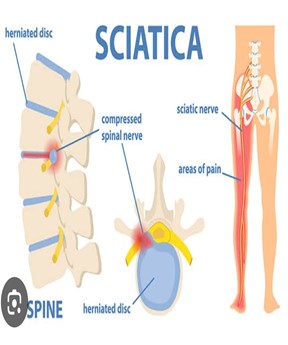
- Radiating pain from low back to thigh, leg and foot
- Numbness, tingling or heaviness of thigh, leg and foot
- Weakness of ankle or toes. These are commonly perceived as inability to lift the foot off the ground while walking (foot drop) or inability to straighten the toes (toe drop)
- Loss of bowel and bladder control in severe disc prolapse
Do all slipped discs require surgery?
As mentioned before, only 35-40% slipped discs irritate the nerve root and cause symptomatic sciatica. Out of the symptomatic sciatica also, most discs resorb with time either naturally or with conservative methods and only 10% of the symptomatic cases finally require surgery.
What are the conservative methods to manage sciatica?
- REST: An acute attack of sciatica requires 3-5 days of bed rest. Bedrest beyond this period is not recommended as it would cause muscle deconditioning and weakness of core muscles, a factor contributing to cause of sciatica
- PAINKILLERS: Analgesic medications for a period of 3-5 days may be given for severe pain. Painkillers reduce pain and inflammation relieving sciatica
- PHYSICAL THERAPY: Initially cold packs for 3-5 days followed by hot packs help relieve inflammation and pain. Other modalities like TENS and IFT are also helpful. Once the pain settles, physical exercises are started with gradually increasing intensity. Exercises focus on core muscles and should always be performed under expert supervision
- LIFESTYLE CHANGES: Following precautions at home and workplace are required
- Regular exercises targeting the core muscles
- Ergonomic chairs at workplaces for jobs demanding prolonged sitting
- Avoid lifting weight or forward bending
- Avoid prolonged driving
What is role of spine injections in slipped disc?
There are different of spine injections for different spine problems. Spine injections relevant to slipped disc is the epidural steroid injection or the selective nerve root block.
Spine injections are a mix of steroids and local anesthetics. They reduce the inflammation around the irritated nerve root and also they numb the nerve root causing pain relief.
The benefits of spine injections in slipped disc are as follows:

- To delay or avoid surgery: Epidural steroid injections reduce inflammation around irritated nerve root, thereby it accelerates the natural healing process of a disc prolapse. This usually provides temporary relief from sciatica but in few cases relief may be permanent. This delays the need for surgery and in some patients, surgery is altogether avoided.
- To aid in rehabilitation: Core strengthening exercises is a pivotal to healing of a disc prolapse and long term pain relief. In many cases, exercises and rehabilitation may not be possible due to chronic pain. Here epidural steroids act as useful tool along with other conservative methods.
- To confirm the problematic disc: Whenever there is disc prolapse at multiple levels, despite clinical examination and MRI there may be a confusion which disc is irritating the nerve root and causing sciatica. In such cases an injection close to the nerve will numb it. This is called a diagnostic test and helps to pinpoint the offending disc.
When do you need surgery for slipped disc?
Around 98% patients with slipped discs do well without surgery. Surgery becomes essential in the following situations:
- Severe pain: Patient doesn’t have any pain relief despite 6 weeks of conservative treatment
- Recurrent pain: Patient gets relief in pain but the pain recurs more than 3 times in a year
- Neurological deficit: Patient develops weakness of ankle or toes, this indicates that nerve root compression is severe and won’t resolve on its own
- Cauda equine syndrome: Patient looses control over urine or stools. This is indicative of very severe compression and is a surgical emergency. Patient should get operated as early as possible.
How is the surgery planned for slipped disc?
Various investigations need to be done before any spine surgery. There are three purpose of investigations being done:
- To confirm the diagnosis: MRI is the basic investigation required for confirming the diagnosis
- To find out any coexisting spine disease: These coexisting disease may be spondylolisthesis, canal stenosis, facet hypertrophy, coexisting spine deformity etc. If any of these coexisting disease if found to be present, then surgical plan may need to be modified or changed. X-ray of lumbo-sacral spine (AP, lateral and dynamic views), CT scan are investigations needed for this purpose.
- To access safety for surgery and anesthesia: Complete blood count, kidney function tests, liver function tests, chest X-ray, electrocardiogram and echocardiogram are required to access general fitness of the patient
What types of surgery can be done for slipped disc?
Removal of the prolapsed disc is called discectomy. Discectomy techniques can be endoscopic discectomy, microdiscectomy, open discectomy and fusion surgeries like TLIF, PLIF, OLIF etc. Disc is a deep structure in the spine. Superficial to it lies the skin, fascia, muscles, ligaments and bones. All these structures are innocent but important structures that have important role to play in stability of spine. Varing degree of damage occur to these tissues in each technique and this damage to these innocent structures is called collateral damage. Lease damage occur in endoscopic discectomy followed by microscopic discectomy, then open discectomy and maximum in fusion surgeries. Lets discuss these techniques one by one.
- Endoscopic discectomy: In endoscopic discectomy, the disc fragment is targeted directly without damaging the surrounding tissues with help of specialized camera system called endoscopes. It is least invasive form of discectomy. There is minimum incision, few or no stitches, minimum blood loss, early rehabilitation and quick recovery. Collateral tissue damage is minimum amongst all the techniques of discectomy and therefore long term pain relief is best.
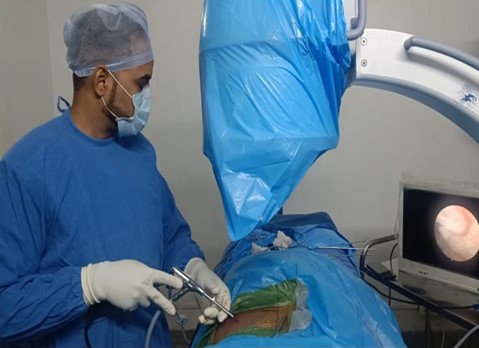
2. Microscopic decompression: The disc is targeted with help of tubular retractors and microscope. This is also a less invasive form of discectomy but collateral tissue damage is more than endoscopic discectomy.

3. Open discectomy: This is the conventional and original form of discectomy. Here all the structures superficial to the disc are damaged to access the disc to varying extend and there is more of collateral tissue damage, involves bigger incision, more blood loss, prolonged rehabilitation and longer recovery time.
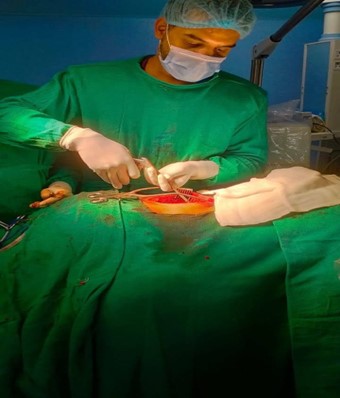
4. Fusion procedures: Fusion means fusing two adjacent vertebra so that they start acting as one. Not only the prolapsed disc but all of the remaining disc is removed and also the spine segment is fixed with help of screws. This procedure is not routinely done for simple disc prolapse problems. They are done if there is coexisting spine disease like recurrent disc herniations, spine instability or spondylolisthesis etc.
What endoscopic procedure we do in slipped disc?
- We do uni-portal spine endoscopy for slipped disc treatments, both by transforaminal and interlaminar technique.
- This is the best form of slipped disc treatment available worldwide at present. The type of surgery depends on the location of the prolapsed disc.
- We evaluate the patient first clinically and then radiologically with MRI and ascertain the position of disc.
- Foraminal, extraforaminal and lateral recess discs if unilateral, are removed by transforaminal technique. This surgery is done under local anesthesia, meaning the patient is totally awake during the procedure and can talk to the doctor in case of any discomfort.
- If there is bilateral slipped disc, or the slipped disc lies centrally in canal or lateral recess, it is removed by interlaminar technique. This surgery is done under general anesthesia.
What should be expected of a slipped disc surgery?
Substantial pain relief should be expected immediately after surgery. However symptoms like numbness, tingling, heaviness and weakness of joints may take longer to recover, say weeks to few months depending on the duration of these symptoms. In rare cases they may not recover also. Bowel and bladder if incontinent are notorious and may take months to years to recover.
How long can someone wait for spontaneous recovery before decision for surgery is made?
Ideally 6-12 weeks is the time for spontaneous recovery of pain of slipped disc. Waiting for period longer than 3 months may worsen the long term pain relief. However there are neurological symptoms like weakness of joints, surgical decision should be made early especially if weakness is increasing with time. The spine surgeon will help you assess the worsening of neurological symptoms by clinal examination.
If urinary and feral incontinence has set in, then it becomes a surgical emergency and surgery should be done at the earliest.

